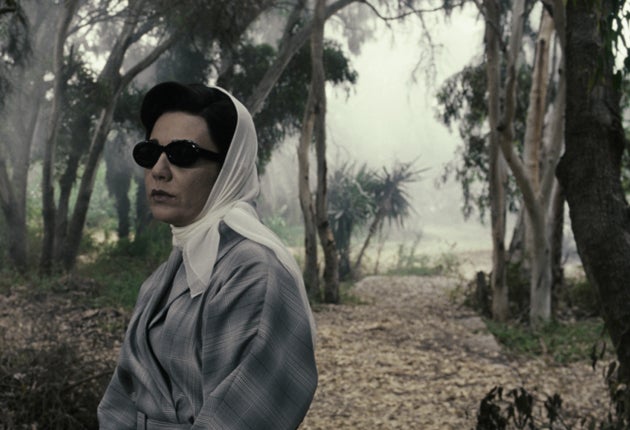Women Without Men, Shirin Neshat, 99 mins (15)
The feature debut by an Iranian-born video artist puts a magical spin on the 1953 British-backed coup in Tehran, as seen through the eyes of four women

If you're familiar with the work of the Iranian-born video artist Shirin Neshat, chances are you're no stranger to neck-ache. Neshat's work in galleries often appears on two facing screens – one on each side of the room – so that you're forever craning between images, essentially editing the film yourself.
Her first cinema feature Women Without Men uses only one screen, but Neshat crams so much into it – imagery, plot, cultural references, history – that if your neck is left unstrained, your head probably won't be. Still, art films shouldn't be afraid to cause headaches, and – unmanageably dense though it is – Women Without Men is a striking, audacious debut.
The film is ostensibly a realistically detailed historical drama, although its more dream-like elements suggest a magical-realist feminist fable. Based on a novella by Shahrnush Parsipur, it's set in Tehran in 1953, when an American-led, British-backed coup unseated the country's popular Prime Minister, Mohammad Mossadegh, and reinforced the power of the Shah – a decisive moment which, the film suggests, marks the beginning of Iran's problems today.
The heroines are four Tehran women. Munis (Shabnam Tolouei), a young single woman, is interested in realities beyond her home, but her domineering brother wants her to marry and live a conservative Muslim life. Her friend, naive and conservative Faezeh (Pegah Ferydoni), who can't see why Munis worries her head over politics, is in for a rude awakening. Fakhri (Arita Shahrzad) is the discontented wife of a general; she rethinks her life when an old flame returns from the West and introduces her to Tehran café society, where Camus and democracy are the conversation topics of choice. And the prostitute Zarin – played by the emaciated Hungarian actress Orsi Tóth – starts to undergo a breakdown when she looks up to see that a client's face is totally featureless, as if covered by cobwebs.
The image of the faceless man is just one of many surreal elements disrupting what would otherwise be a straight period drama. Munis achieves her political awakening only after she has jumped to her death, been hastily buried, then magically returned to life. The film's dominant image is of a garden that appears to be located in the real world – Fakhri buys it as a country retreat – but is also a protean dream space, sometimes downright menacing, sometimes a balmy haven. It is first seen in one of the breathtaking virtuoso shots contrived by Neshat and her cameraman, Martin Gschlacht: the camera creeps at ground level along a stream, passes impossibly through a hole in a wall, then soars up above a canopy of trees.
The film is generally strongest when occupying a largely realistic yet stylised register – when Munis, in a black veil, is caught up in two converging groups of white-shirted men, or when a line of protesters runs diagonally across the screen, pursued by soldiers. Neshat and her designers have done wonders in transforming their Moroccan locations into an evocative 1950s Tehran – a complex, cosmopolitan place very different from the stark city of today's Iranian films (Neshat's is a German-Austrian-French co-production).
As well as images of traditional Muslim city life – mosques, hammams – we see a crumbling brothel, elegant highbrow gatherings, exteriors bustling with unrest. Shot in a faded palette verging on sepia, the film's mix of realism and imagination suggests something between the epic historical drama of the Bertolucci school and the distanced, theatrical approach of Greece's Theo Angelopoulos.
Neshat and her co-writer Shoja Azari can't quite carry the quantity of material they take on, and the film feels over-stuffed into its 99-minute frame. We never get to know any of the heroines quite well enough, and their respective fates come across as slightly schematic, Munis becoming politicised, Fakhri recreating herself as an independent woman of culture, Faezeh learning to shake off her sexual and cultural chains, and Zarin becoming a martyr, absorbing the woes of oppressed women. And just as we're moving into the reality of the coup, the film keeps slipping back into apparent allegory. It's hard to take in the complexity of Iran's social changes when we're constantly asked to contemplate the meaning of a tree crashing into a house or – in one of the film's more precious, even kitsch images – Zarin planting a field of paper flowers.
Women Without Men is also much stronger on imagery than it is on acting, although Arita Shahrzad stands out as middle-aged Fakhri trying to hold on to her sexual and social confidence. Even so, while it lacks the directness and visual purity of Neshat's gallery work, this is a passionate, urgent film. Some modish gallery artists have moved into narrative film as if it were a populist easy option, but not Neshat – she seizes on cinema with a furious invention and appetite for imagery. Awkward and overloaded Women Without Men may be, but it's the real thing.

Watch Apple TV+ free for 7 day
New subscribers only. £8.99/mo. after free trial. Plan auto-renews until cancelled.
ADVERTISEMENT. If you sign up to this service we will earn commission. This revenue helps to fund journalism across The Independent.

Watch Apple TV+ free for 7 day
New subscribers only. £8.99/mo. after free trial. Plan auto-renews until cancelled.
ADVERTISEMENT. If you sign up to this service we will earn commission. This revenue helps to fund journalism across The Independent.
Next Week:
Jonathan Romney dives into the strangeness of Wild Grass, the comeback film by French veteran Alain Resnais
Join our commenting forum
Join thought-provoking conversations, follow other Independent readers and see their replies
Comments